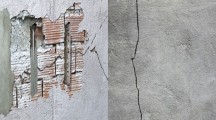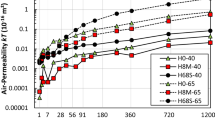Abstract
This paper presents a novel methodology to appropriately account for boundary conditions in numerical analyses of moisture fields in cementitious materials. The proposed methodology consists of using experimentally obtained moisture emissivity coefficients together with the vapour pressure difference between the environment and the exposed surface (based on the average surface humidity content). The performance of such methodology (implemented on DuCOM, a computational code suitable for calculation of moisture/temperature fields in cementitious materials) is evaluated by comparing the numerical predictions with the experimental results presented in the Part I companion paper. Influences of the many environmental conditions reported in Part I are investigated for validation of the proposed numerical methodology: temperature, relative humidity, wind speed and age of exposure of specimens. Furthermore, an additional numerical formulation for inclusion of the effect of evaporative cooling, based on the computation of additional heat fluxes induced by evaporative moisture losses, is presented, together with a validation example. Finally, two numerical sensitivity analyses are put forward for clarification of the relative importance of the parameters involved in moisture loss from cementitious materials, as well as the relevance of the evaporative cooling.
Résumé
Cet article présente une nouvelle méthodologie afin de mieux tenir compte des conditions limites lors d’analyses numériques des champs d’humidité dans les matériaux cimentaires. La méthodologie proposée consiste à utiliser des coefficients d’émissivité d’humidité obtenus expérimentalement associés avec la différence de pression de vapeur entre l’environnement extérieur et la surface exposée du béton (basée sur le contenu moyen de l’humidité à la surface). La validité de cette méthodologie (intégrée dans un logiciel de calcul des champs d’humidité et de température des matériaux cimentaires—appelé DuCOM) est évaluée en comparant les prédictions aux résultats expérimentaux rapportés dans l’article précédant (partie 1). Les influences des nombreuses conditions environnementales rapportées dans la partie 1 y sont vérifiées et validées, notamment: la température, l’humidité relative, la vitesse du vent et la durée d’exposition des spécimens. En outre, une formulation numérique additionnelle pour inclure l’effet du refroidissement par évaporation (basée sur le calcul des flux de chaleur additionnels induits par évaporation) est présentée et validée avec un exemple. En conclusion, deux analyses de sensibilité sont présentées pour clarifier l’importance relative des paramètres impliqués dans la perte d’humidité des matériaux cimentaires et pour démontrer la pertinence de l’influence du refroidissement par évaporation.























Similar content being viewed by others
References
Azenha M, Maekawa K, Ishida T, Faria R (2007) Drying induced moisture losses from mortar to the environment - Part I–experimental research. Mater Struct DOI:10.1617/s11527-007-9244-y
Maekawa K, Ishida T, Kishi T (2003) Multi-scale modeling of concrete performance. Integrated material and structural mechanics. J Adv Concrete Technol 1(2):91–126
Maekawa K, Chaube R, Kishi T (1999) Modelling of concrete performance. E&FN SPON 308
Al-Fadhala M, Hover K (2001) Rapid evaporation from freshly cast concrete and the Gulf environment. Constr Building Mat 15:1–7
Schindler A, Ruiz J, Rasmussen R, Chang G, Wathne L (2003) Concrete pavement temperature prediction and case studies with the FHWA HIPERPAV models. Cement Concrete Compos 26(5):463–471
Selih J, Sousa A, Bremner T (1996) Moisture transport in initially fully saturated concrete during drying. Transp Porous Media 24:81–106
Kishi T, Maekawa K (1995) Multi-component model for hydration heating of portland cement. Concrete lib JSCE–Jap Soc Civil Eng 28:97–115
Masmoudi W, Prat M (1991) Heat and mass transfer between a porous medium and a parallel external flow. Application to drying capillary of porous materials. Int J Heat Mass Transfer 34(8):1975–1989
Uno PJ (1998) Plastic shrinkage cracking and evaporation formulas. ACI Mater J 95(4):365–375
ACI (2001) Guide to curing concrete. ACI Committee Reports, A. C. Institute, ed.
Jones F (1992) Evaporation of water with emphasis on applications and measurements. Lewis Publication, Michigan
Marek K, J S (2000) Analysis of the evaporation coefficient and the condensation coefficient of water. Int J Heat Mass Transfer (44):39–53
Bansal P, Xie G (1998) A unified empirical correlation for evaporation of water at low air velocities. Int Comm Heat Mass Transfer 25(2):183–190
Pauken M (1999) An experimental investigation of combined turbulent free and forced evaporation. Exp Thermal Fluid Sci. (18):334–340
Eames I, Marr N, Sabir H (1997) The evaporation coefficient of water: a review. Int J Heat Mass Transfer 40(12):2963–2973
Azenha M, Maekawa K, Ishida T, Faria R (2005) Heat and moisture transfer between concrete and the environment. LABEST–internal reports
Nilsson L-O (1996) Interaction between microclimate and concrete–A prerequisite for deterioration. Const Building Mater 10(5 SPEC. ISS.):301–308
Chuntranuluck S, Wells C, Cleland A (1998) Prediction of chilling times of foods in situations where evaporative cooling is significant–Part 1 method development. J Food Eng 37:111–125
Ishida T, Maekawa K, Kishi T (2007) Enhanced modeling of moisture equilibrium and transport in cementitious materials under arbitrary temperature and relative humidity history. Cem. Conc. Res 37(4):565–578
Acknowledgement
Financial support from the Portuguese Foundation for Science and Technology, through the PhD grant provided to the first author (SFRH/BD/13137/2003) and the Research Project POCI/ECM/56458/2004, is gratefully acknowledged.
Author information
Authors and Affiliations
Corresponding author
Rights and permissions
About this article
Cite this article
Azenha, M., Maekawa, K., Ishida, T. et al. Drying induced moisture losses from mortar to the environment. Part II: numerical implementation. Mater Struct 40, 813–825 (2007). https://doi.org/10.1617/s11527-007-9243-z
Received:
Accepted:
Published:
Issue Date:
DOI: https://doi.org/10.1617/s11527-007-9243-z




